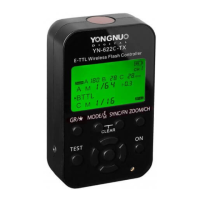The Other YN-622C User Guide v.4.09
11/12/2014 Part 1 – The System Page 12 of 64
622C-TX Flash Controller
Control by LCD Display and Camera
C-TX Functions
Simple or Complex setups
• The controller’s LCD menu provides an alternative to the camera’s External Flash menus,
and enables extensions not provided by Canon.
• The minimum is one C-TX controller on camera, and one remote 622C under flash. Or, add
more remote 622Cs and various flashes.
• Lights can be at any angle to the camera, but walls may reduce range.
• Will also sync with most studio flash lighting, including by time-adjusted Super Sync.
Control/Trigger Modes
• Full Remote – Uses Canon 5-pin hotshoe signals.
• Basic hotshoe – Uses single-pin hotshoe (Non-Canon cameras).
• Basic without hotshoe – Uses camera’s PC-Sync out connection to C-TX’s PC-sync In.
Flash Modes
• Independent Groups (E-TTL + FEC / Manual Levels / Super Sync / Off) mode
• E-TTL global (FEC / Ratio + Backlight / FEB )
• Multi/Stroboscopic global
Independent Group Settings
E-TTL
• E-TTL II with global FEC.
• FEC by each group in E-TTL.
Manual
• Manual flash output levels, 1/1 to 1/128.
Super Sync
• Super Sync – for studio flashes (monolights and pack-and-heads).
Group Off
• Previous setting for group is not remembered.
• The Free Mask feature temporarily sets Groups A and B to off, and uses Group C only to
produce a cutout mask, then returns to the previous main settings.
Flash Zoom
• Remote Zoom by Group, including Auto, 24mm – 105mm.
• Local Zoom Lock can over-ride C-TX setting.
Sync Modes
• 1
st
Curtain Sync; shutter speed up to camera’s x-sync.
• 2
nd
Curtain Sync up to 1/8000s, including with HSS.
• High Speed Sync (HSS or FP); Max. Sync Speed: 1/8000s, depending on camera and
flash.
• Super Sync for non-HSS flashes. The timing of the advanced sync is adjustable from 0.0 to
2.0. Max. Sync Speed: 1/8000s, depending on camera. PC-sync port can output 1CS / 2CS
/ HSS / Super Sync signal to trigger studio flash.
• Single-contact camera and single-contact flash sync at max. 1/250s.

